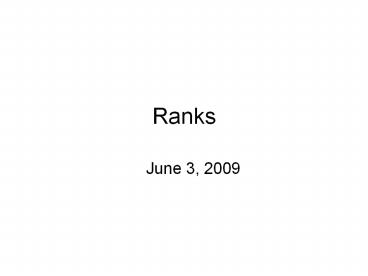Ranks - PowerPoint PPT Presentation
1 / 52
Title:
Ranks
Description:
Title: Random matrix theory and ranks of elliptic curves Author: Janet Conrey Last modified by: brian Created Date: 6/13/2005 2:19:18 PM Document presentation format – PowerPoint PPT presentation
Number of Views:47
Avg rating:3.0/5.0
Title: Ranks
1
Ranks
- June 3, 2009
2
(No Transcript)
3
(No Transcript)
4
Which integers m are the sum of two rational
cubes?
5
Which integers m are the sum of two rational
cubes?
6
346 is the sum of two rational cubes
7
Selmers table of A for which
has infinitely many solutions
8
Conjecture from random matrix theory
9
(No Transcript)
10
When p is 1 mod 3 there are three solutions to
with a congruent to 2 mod 3. One of these has b
divisible by 3. The corresponding a is defined to
be
p7, 4p28
11
Gauss showed that the number of solutions modulo
p to
is given by
12
Conjecture (Watkins) Fix a prime p. Then
13
For example
14
(No Transcript)
15
Elliptic curves
Let E be an elliptic curve with equation
16
(No Transcript)
17
Usually, when the root number is 1 the rank is 0
and when the root number is -1 the rank is 1
18
(No Transcript)
19
By a conjecture of Goldfeld, we expect that in
the family of quadratic twists the rank will be 0
almost all of the time that the root number is 1
and that the rank will be 1 almost all of the
time that the root number is -1.
Question How often do we get rank 2 or 3 in the
family of quadratic twists of a fixed elliptic
curve?
20
By random matrix theory we expect rank two curves
to occur in the family of quadratic twists of E
for about
21
Example
22
Alternatively
23
(No Transcript)
24
Formula for central value
Gross found
25
(No Transcript)
26
The quadratic twists form a family that seems to
have orthogonal symmetry. Since we are
restricting attention to L-functions with a
sign in the functional equation, we should model
the distribution of values of these L-functions
by the distribution of values of characteristic
polynomials from SO(2N).
In particular, the moments should match up
27
(No Transcript)
28
Keating and Snaith formula for sth moment of
orthogonal characteristic polynomials
Probability density function
For small and large N,
29
(No Transcript)
30
(No Transcript)
31
Same as last slide but with more than 2000
curves. The theta series were supplied by Gonzalo
Tornaria and Fernando Rodriguez-Villegas.
32
(No Transcript)
33
How are rank 2 twists distributed in arithmetic
progressions?
Conjecture (C, Keating, Rubinstein, Snaith)
34
(No Transcript)
35
A second order approximation
36
(No Transcript)
37
(No Transcript)
38
(No Transcript)
39
(No Transcript)
40
What about rank 3 in the family of quadratic
twists?
41
Nina Snaiths derivative calculation
42
Note The rightmost pole is at s-3/2.
43
Suggestion for the frequency of rank 3 vanishing
Might be plausible based on Elkies data for rank
3 curves among twists of the congruent number
curve. RMT suggests
44
Elkies data about rank 3 twists of the congruent
number curve, sorted by Watkins
The first column is the prime. The second column
is the number of rank 3s in square residue
classes. The third column is the number of rank
3s in non-square classes. The fourth column is
the ratio of columns two and three. The last
column is the RMT prediction.
45
Saturday night conjecture
46
(No Transcript)
47
(No Transcript)
48
(No Transcript)
49
Quadratic twists of weight 4 and 6 modular forms.
50
3 1.18 1.11 5, 0.55 0.59 11, 1.06 1.15
13, 0.86 0.84 17, 0.84 0.76 19, 1.35 1.53
23, 0.92 0.87 29, 1.14 1.22 31, 0.99 1.05
37, 1.19 1.17 41, 0.90 0.82 43, 0.93 0.90 47,
0.87 0.76 53, 1.06 1.06 59, 0.79 0.75 61,
1.14 1.15 67, 0.95 0.94 71, 1.16 1.17 73,
1.14 1.08 79, 0.93 0.93 83, 1.21 1.18 89,
0.91 0.87 97, 0.97 0.98
Vanishings of twists of the level 7 weight 4 cusp
form. There are 1155 vanishings out of 13298378
twists up to d100,000,000
The first column is the prime, the second is the
random matrix prediction the last is the data.
The RMT prediction is
51
Twists of a weight 2 form by a cubic Dirichlet
character
Work of David, Fearnley, and Kivilevsky.
The RMT model involves a unitary model.
52
Can we do this for degree 4 L-functions?
- Can we do this for degree 4 L-functions?
- Quadratic twists of a fixed L-function?
- L-functions associated with Siegel modular forms
- L-functions associated with symmetric cube
L-functions - L-functions associated with Rankin Selberg
convolutions































